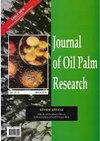SIMULATION OF ENERGY CONSUMPTION IN STERILISATION PROCESS USING ASPEN PLUS AND RESPONSE SURFACE METHODOLOGY
IF 1.3
4区 农林科学
Q2 Agricultural and Biological Sciences
引用次数: 0
Abstract
Improving energy consumption in the palm oil milling process is regarded as one of the sustainable palm oil elements. Thus, this study highlights the use of ASPEN Plus-response surface methodology (RSM) approach to simulate and optimise the energy consumption of sterilisation process based on exergy analysis ( i.e. exergy destroyed) and chemical reaction. ASPEN Plus V8.6 was employed to simulate the sterilisation process and then optimised using RSM. The validation of simulation results with experimental results demonstrating error values of less than 5.0%. Comparison of outlet stream simulation results with mill’s data also showed deviation values less than 10.0%. These indicated that the actual values were in good agreement with model prediction. For optimisation, three variables were considered, namely pressure, steam mass flow and sterilisation time. For conventional steriliser operated at 2.8 bar, 90 min and 14 580 kg/hr steam mass flow, the exergy destroyed was 5259.3 MJ/hr. Under optimised conditions at 5 bar pressure, 70 min and 17 550 kg/ hr steam mass flow, the exergy destroyed was 3493.9 MJ/hr. In comparison to conventional conditions, the heat loss was reduced by 33.6%. This approach is considered sustainable as it could predict the performance of industrial process without impacting processing time, cost and resources consumption.利用aspen plus和响应面方法模拟灭菌过程中的能量消耗
提高棕榈油加工过程中的能源消耗被认为是可持续的棕榈油要素之一。因此,本研究强调使用ASPEN Plus响应面方法(RSM)来模拟和优化基于火用分析(即火用破坏)和化学反应的消毒过程的能耗。采用ASPEN Plus V8.6模拟灭菌过程,然后使用RSM进行优化。模拟结果与实验结果的验证表明,误差值小于5.0%。出口流模拟结果与磨机数据的比较也显示偏差值小于10.0%。这表明实际值与模型预测非常一致。为了优化,考虑了三个变量,即压力、蒸汽质量流量和灭菌时间。对于在2.8巴、90分钟和14580千克/小时蒸汽质量流量下运行的常规杀菌器,破坏的有效能为5259.3兆焦耳/小时。在5巴压力、70分钟和17550千克/小时蒸汽质量流量的优化条件下,破坏的火用为3493.9兆焦耳/小时。与传统条件相比,热损失减少了33.6%。这种方法被认为是可持续的,因为它可以在不影响加工时间、成本和资源消耗的情况下预测工业过程的性能。
本文章由计算机程序翻译,如有差异,请以英文原文为准。
求助全文
约1分钟内获得全文
求助全文
来源期刊

Journal of Oil Palm Research
农林科学-食品科技
CiteScore
2.60
自引率
30.80%
发文量
69
审稿时长
>12 weeks
期刊介绍:
JOURNAL OF OIL PALM RESEARCH, an international refereed journal, carries full-length original research papers and scientific review papers on various aspects of oil palm and palm oil and other palms. It also publishes short communications, letters to editor and reviews of relevant books. JOURNAL OF OIL PALM RESEARCH is published four times per year, i.e. March, June, September and December.
 求助内容:
求助内容: 应助结果提醒方式:
应助结果提醒方式:


